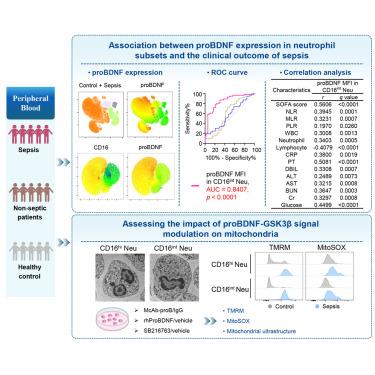Targeting proBDNF in neutrophil subsets: Sepsis biomarker discovery and insights into mitochondrial hyperactivation
IF 4.1
2区 综合性期刊
Q1 MULTIDISCIPLINARY SCIENCES
引用次数: 0
Abstract
Sepsis, characterized by dysregulated immune responses, necessitates biomarkers and therapies. We conducted a prospective multicentric observational study involving sepsis patients and control groups. The proportions and brain-derived neurotrophic factor precursor (proBDNF) expression of blood neutrophil subsets were detected, and their clinical value was evaluated via correlation analysis and receiver operating characteristic curve analysis. ProBDNF was significantly upregulated in immature neutrophils (CD16int Neu) in sepsis patients and slightly elevated in mature Neu (CD16hi Neu). ProBDNF expression in CD16int Neu showed promising diagnostic value for sepsis, with a specific positive correlation with disease severity, prognosis, and organ dysfunction. CD16hi Neu from sepsis patients presented hyperactivated mitochondria, as shown by their increased mitochondrial membrane potential and length, which was reversed by neutralizing proBDNF. ProBDNF expression in circulating CD16int Neu may be a promising biomarker of sepsis. Targeting proBDNF in CD16hi Neu has the potential to control mitochondrial hyperactivation during sepsis.

在中性粒细胞亚群中靶向proBDNF:败血症生物标志物的发现和线粒体过度激活的见解
脓毒症以免疫反应失调为特征,需要生物标志物和治疗。我们进行了一项涉及败血症患者和对照组的前瞻性多中心观察性研究。检测血中性粒细胞亚群比例及脑源性神经营养因子前体(proBDNF)表达,通过相关分析及受试者工作特征曲线分析评价其临床价值。脓毒症患者未成熟中性粒细胞(CD16int Neu)中的ProBDNF显著上调,成熟中性粒细胞(CD16hi Neu)中的ProBDNF略有升高。ProBDNF在CD16int Neu中的表达显示出对脓毒症的诊断价值,与疾病严重程度、预后和器官功能障碍有特定的正相关。来自脓毒症患者的CD16hi Neu表现为线粒体过度活化,表现为线粒体膜电位和长度增加,这可以通过中和proBDNF来逆转。ProBDNF在循环CD16int Neu中的表达可能是一种有希望的脓毒症生物标志物。靶向CD16hi Neu中的proBDNF有可能控制脓毒症期间的线粒体过度激活。
本文章由计算机程序翻译,如有差异,请以英文原文为准。
求助全文
约1分钟内获得全文
求助全文
来源期刊

iScience
Multidisciplinary-Multidisciplinary
CiteScore
7.20
自引率
1.70%
发文量
1972
审稿时长
6 weeks
期刊介绍:
Science has many big remaining questions. To address them, we will need to work collaboratively and across disciplines. The goal of iScience is to help fuel that type of interdisciplinary thinking. iScience is a new open-access journal from Cell Press that provides a platform for original research in the life, physical, and earth sciences. The primary criterion for publication in iScience is a significant contribution to a relevant field combined with robust results and underlying methodology. The advances appearing in iScience include both fundamental and applied investigations across this interdisciplinary range of topic areas. To support transparency in scientific investigation, we are happy to consider replication studies and papers that describe negative results.
We know you want your work to be published quickly and to be widely visible within your community and beyond. With the strong international reputation of Cell Press behind it, publication in iScience will help your work garner the attention and recognition it merits. Like all Cell Press journals, iScience prioritizes rapid publication. Our editorial team pays special attention to high-quality author service and to efficient, clear-cut decisions based on the information available within the manuscript. iScience taps into the expertise across Cell Press journals and selected partners to inform our editorial decisions and help publish your science in a timely and seamless way.
 求助内容:
求助内容: 应助结果提醒方式:
应助结果提醒方式:


